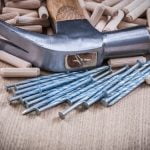Introduction to Combination Squares
Combination squares are versatile tools popularly used in woodworking and metalworking. This multipurpose tool is typically composed of four main components: a ruler, a level, standard 45-degree miter markings, and an adjustable square head set at 90 degrees. Commonly used for checking measurements and ensuring accuracy of cuts, combination squares can also be used as depth gauges, protractors and other specialized jobs in carpentry and machining.
There are two main types of combination squares available on the market”standard models designed for general purpose use and premium quality squares made from high-grade materials such as stainless steel or hardened steel. Standard squares usually feature a ruler graduated in 16ths of an inch but can also come with different metric graduations for versatile use. Most also feature brass screws and calibrated heads to enable precise adjustment of the ruler against the square head.
Premium quality combination squares are ideal for professional woodworkers due to their superior build quality. These models tend to have greater durability, more accurate centering capabilities, higher accuracy scale readings, improved readability and overall more precise measurements. They’re also much easier to adjust compared to standard models, making them an excellent choice for woodworking tasks that involve precision measuring.
When choosing the best combination square for woodworking projects, consider your level of expertise. If you’re just starting out in woodworking crafts or if you’re working on simple projects such as furniture assembly or cutting simple joints like dados or rabbets, then a basic model will do just fine. However professional builders may want to opt for higher end models designed specifically for greater accuracy in measuring complex intersections or complex joinery techniques like dovetails or dowels joints etc. Consider how frequently the tool will be used, its intended purpose and price range before selecting the best fit from among the various available models on the market today.
Three Features to Consider When Choosing a Combination Square
1. Accuracy: When it comes to combination squares, accuracy is of utmost importance. Look for a model with markings that are easy to read and accuracy that is certified by the manufacturer. The scale should have increments as small as possible to ensure precise measurements.
2. Construction: Combination squares come in a variety of materials such as stainless steel, aluminum, plastic, and brass. Stainless steel is the most durable and reliable material, but aluminum and plastic may be sufficient depending on your needs. Choose a construction that will stand up to years of use and won’t rust over time.
3. Durability: Quality materials and construction are important for any tool, but when it comes to combination squares it’s especially important because the square must remain steady over long periods of time without wobbling or slipping out of position while you measure something accurately. Look for models that are built to last with hardened blades and non-slip grip surfaces on the handles or knobs.
What Makes a Quality Combination Square for Woodworking?
When looking for a combination square for woodworking it is important to find one that can accurately measure and make accurate marks. Quality combination squares should have measurements in both metric and imperial units, be well balanced and fit comfortably in the hand. The ruler should be made of high-grade metal or alloy, have micro-fine material underneath the head ensuring readings as close to zero as possible and also have clearly etched graduations which will not wear over time. The handles should be strong and comfortable to grip with a positive locking system that prevents unwanted movement. The blades should come with steel or cast iron heads, have adjustable depth stops which provide accurate depth settings across different materials, and be hardened and tempered to lengthen their life span. Finally, if the model has any additional features they should be professional grade such as extra strength scribed edges on the protractor head or variable pitch knurling on the screw that allow for finer adjustments during work.
Top Ten Combination Squares for Woodworking
1. Starrett Combination Square Set: Precision machined with a rust-resistant satin chrome finished surface and blades, this combo square set is the most precise, durable and accurate set on the market. The set’s twelve pieces include four combination squares in different sizes, plus a base plate, protractor head, center head, center scriber and spirit level vial.
2. Mitutoyo Combination Square Kit: This kit features two combination squares made of stainless steel that is resistant to dust, acids and other corrosive liquids making them suitable for use in woodworking workshops with high humidity levels. For added accuracy and convenience this kit also includes a ruler guide that allows woodworkers to mark lines precisely along the edge of any board or panel.
3. Swanson Speed Square Set: This three piece set includes a swivel head for transferring measurements between opposite edges or corners as well as two double 90 degree heads for quick calculation of angles without guessing and wasting material or time. The aluminum construction of these squares makes them light weight but extra sturdy so they won’t fail you during difficult tasks.
4. Irwin Tools Combination Square: Featuring an adjustable milled face designed to fit perfectly against worksurfaces while working on delicate projects such as cabinetry; this tool will keep the shavings out of your way while you work on cutting those precise corners and joints quickly and accurately. It’s 45° angle maker ensures you can draw accurate lines up to 90° without much effort at all.
5. Stanley Handyman Series Combination Squares: Affordably priced in multiple sizes for various uses; these tools are great for beginner woodworkers who may require some extra help getting started – especially if coupled with one of Stanley’s many instructional woodworking DVDs! This series also offers an array of blade lengths from six inches all the way up to 36 inches so there will be something here that suits your needs perfectly!
6. General Purpose Combo Square Set: Ideal for any type of woodwork including carpentry, molding fabrication and construction this complete utility toolkit has everything required for general measuring jobs around the workshop or shop floor! Including one 45° miter square and two standard plastic combination squares; this selection will provide you with all the right accessories at an attainable pricepoint!
7. Johnson & Associates Combination Squares: These heavy duty combination squares come with hardened tempered blades made from stainless steel – ensuring they are built strong enough withstand repetitive impact stresses while cradled within their aluminum frame bodies making them ideal options when it comes to working with hardwoods like maple or oak!
8. Grizzly Industrial Combination Squares: With double marked scales printed directly on their rust-free stainless steel bezels these ruggedized tools are calibrated by laser making them just about as accurate as any woodsman could ever need! A protective epoxy finish also keeps chips from chipping off into your workpieces protecting your craftsmanship from unforeseen errors in measurement!
9. Rockwell Versa Clip Tool Combo Kit: The most compact assortment on our list is no less capable than its larger friends – despite being half their size; this space saving toolkit still manages to see clear of exact meeting points even when tasked with precision layout assignments leaving your woodworking projects completely free from error!
10 . Flexcut Multi-Scribe Combo Kit: Last on our list – but definitely not least – is Flexcut’s Multi-Scribe Kit which comes complete with nine separate instruments designed specifically for marking out perfect lines accompanied by a replaceable carbide cutter wheel mounted onto its claws allowing scratches perpendicular cross sections exactly where you want them without fail everytime!
How to Use A Combination Square To Measure Accurately
Using a combination square to measure accurately is not as difficult as it may seem. To begin, securely fasten the combination square to your workpiece with clamps or other appropriate tools. Adjust the combination square so the base is aligned parallel to your workpiece. Then, extend the blade out and ensure that it is smooth and level against your workpiece using the markings on the outside of the base. Once this is done, you can use either the calibrated edges of the blade or its cut-out protractor to measure angles, depths and lengths.. The combination square can also be flipped over for measuring longer levels or grids. Finally, adjust the locking screw to secure your measurement and voila — you have an accurate measure!
Maintenance Tips to Keep Your Combination Square Accurate
To help keep your combination square accurate, here are some tips on how to maintain it:
1. Periodically inspect the blade for flatness and make sure the edges are free of any nicks or burrs. It is especially important to check that the edge of the blade hasn’t been warped by using too much pressure when securing it into place.
2. Clean off any dirt or gunk from the blade and body with a damp cloth whenever necessary. This will ensure that there aren’t any particles obstructing it from making straight cuts and measuring accurately against surfaces.
3. Use light motor oil to lightly lubricate the moving parts to help them move smoother when sliding back and forth or turning through different angles of measurement.
4. Store your combination square in a dry place when not in use so that rust doesn’t form on the surface of the metal head and blade assembly over time due to exposure to moisture or humidity levels in your shop environment.
Final Thoughts
Choosing the right combination square for your woodworking projects can make all the difference to ensure precision and accuracy. Before purchasing a combination square, consider what kind of project you are working on and your budget. Quality matters when it comes to tools; higher-end brands tend to last longer while also providing improved features such as etched metal faces and adjustable settings. To get the most out of your investment, educate yourself on choosing between combination squares with metric or imperial measurements, consider if you need extra features like a protractor head or scriber, and how easy it is to read. Additionally, look for models that include accessories like machinists’ blocks, center heads, levels and columns ” these are useful if you are looking for more versatility from your investment into a combination square. Finally, always wear safety gear when woodworking and make sure that you understand how to operate the combination square correctly before starting any project.

Hi everyone! I’m a woodworker and blogger, and this is my woodworking blog. In my blog, I share tips and tricks for woodworkers of all skill levels, as well as project ideas that you can try yourself.





